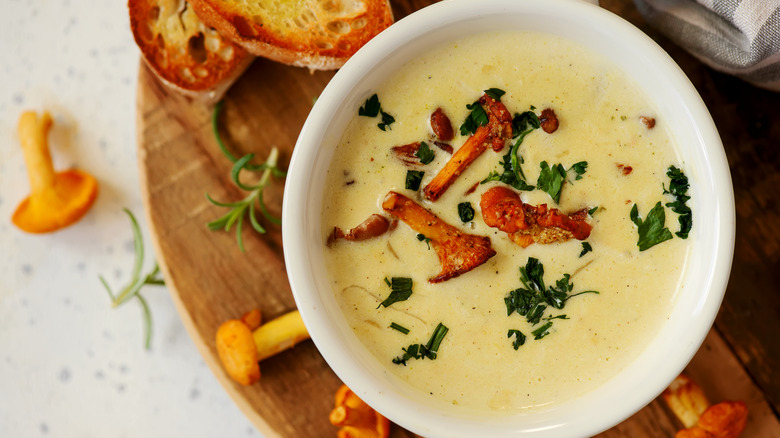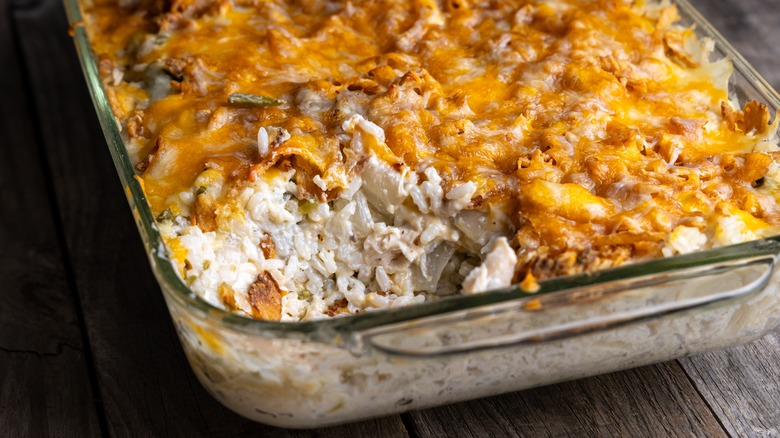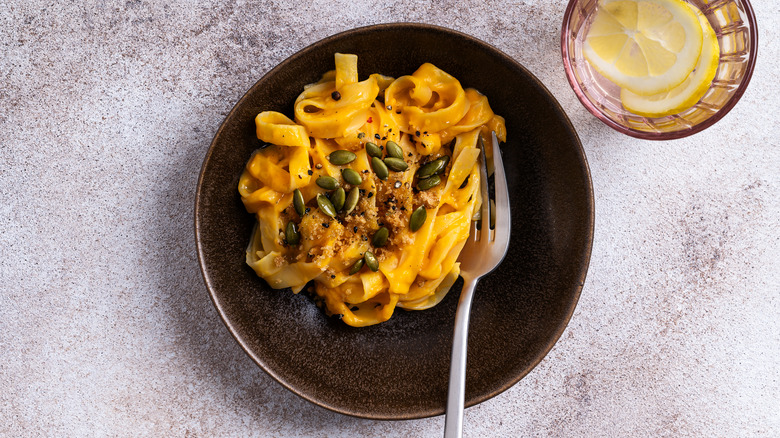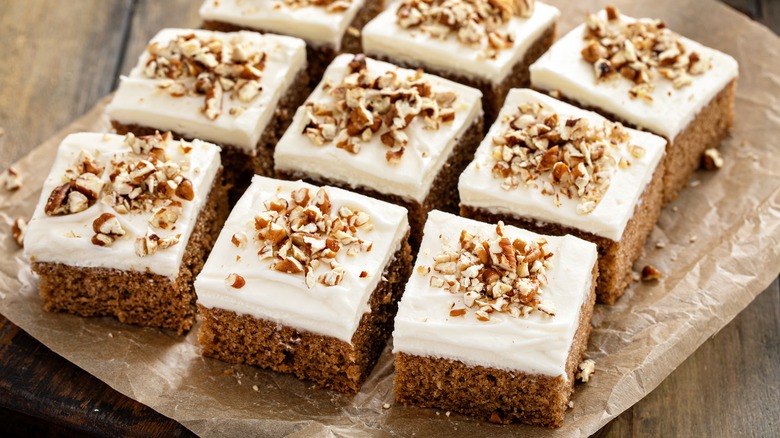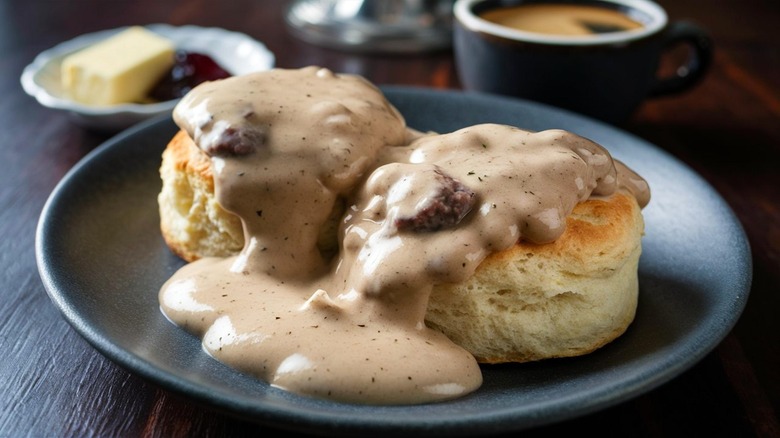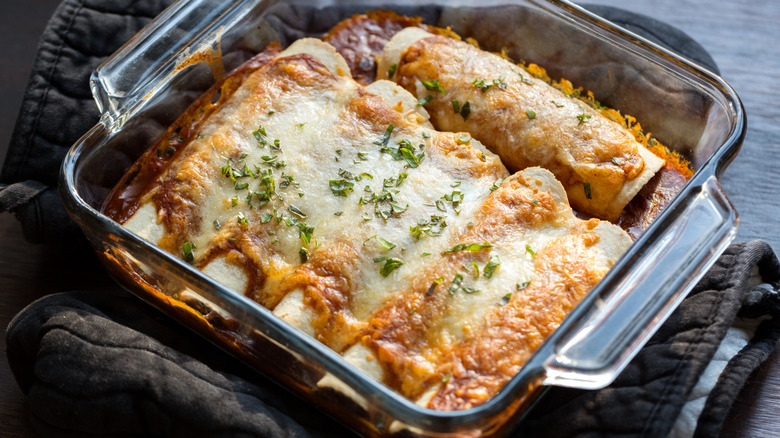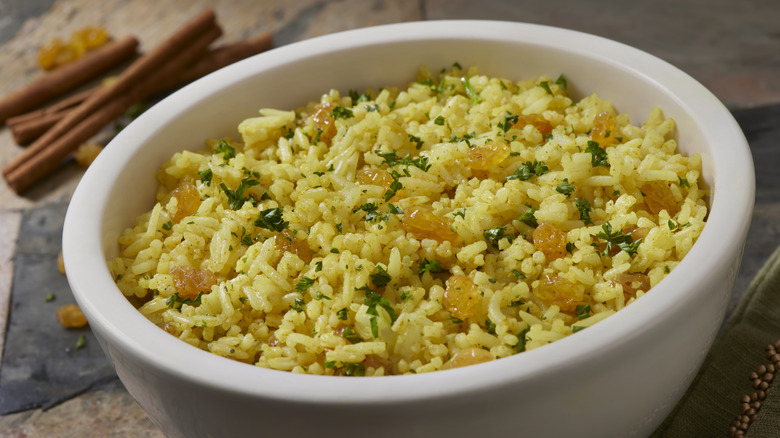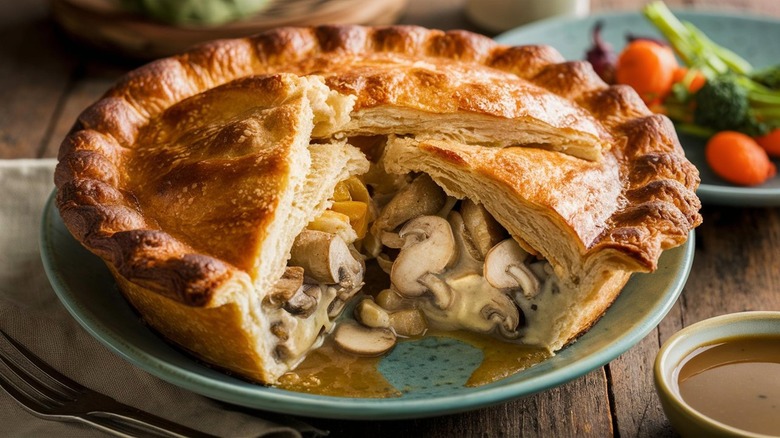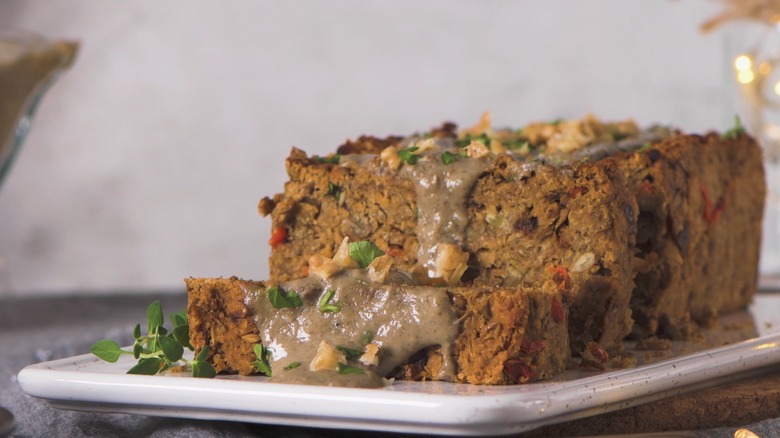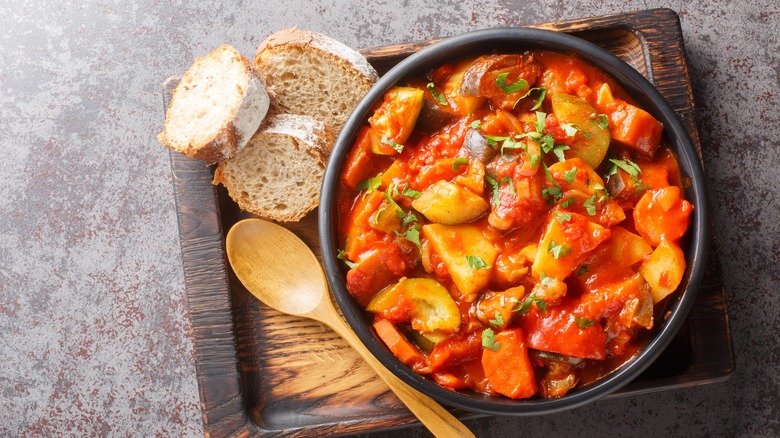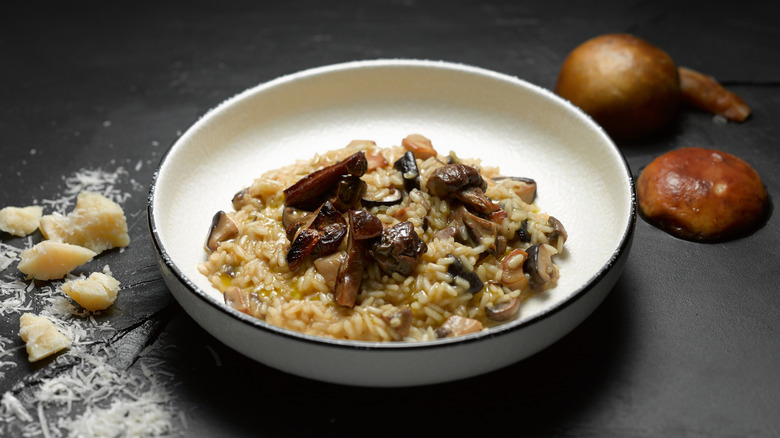11 Delicious Ways To Use Leftover Soup
Warming, comforting, and nutritious, soup is practically a perfect meal. Even so, eating leftovers can get boring, and you might not fancy another night of the same old dinner. That's why you might be interested in some of these ways to use leftover soup. There will also be times when you don't have enough left over to feed everyone in your household, but you can make a more substantial meal by repurposing it into something new.
Before you get started, you should know how long it takes for most soups to go bad. Assuming you've stored it correctly (refrigerating it within two hours of cooking and setting the fridge temperature below 40 degrees Fahrenheit), it should last for around five days. That said, some soups, such as those containing seafood, go off more quickly. Using your senses is usually a good indicator. If it looks or smells bad, it's best to err on the side of caution and get rid of it.
Once you know it's good to use, there are all kinds of ways to repurpose it. Turn it into sauces or gravies, put it in pies and casseroles — all these and more. Some of these ideas are based on recipes that use canned soup, but homemade is even better. Having a range of delicious ways to use leftover soup not only adds more flavor to dishes but reduces food waste. So, you can eat something tasty and feel good about your frugal, sustainable ways. It's a total win-win.
Throw leftover soup in casseroles
Since they cook in the oven, casseroles are great hands-off meals or side dishes. You don't have to watch over them carefully, stirring or flipping. Just let the oven do the work. And they're even easier to make when you use leftover soup to help flavor them.
You've probably already made dishes like this that use soup. For instance, green bean casserole made with condensed mushroom soup is a common sight on Thanksgiving tables — although it's great at any time of year. These recipes tend to call for canned soup, but homemade versions are great, too.
The only thing you need to be mindful of is the texture. Generally, they ask for condensed soups with thick, creamy textures. Now, homemade soup tends to thicken significantly in the fridge. Sometimes after a day or two, it will have the consistency of a condensed soup, sliding out of their Tupperware in a lump that holds its shape, practically sliceable. If this is the case, you're good to mix the soup with other ingredients right away. If not, you'll need to reduce the soup by roughly half before using it.
But, what soup should you use? And what type of casserole should you make? Well, this depends. Creamy soups like cream of mushroom, leek and potato, or cream of celery make great additions to casseroles. French onion also adds a lot of flavor. However, you can experiment. You can also try a wide range of casseroles. Beyond green bean, there's tuna, cabbage roll, tater tot, or cheesy grits, to name just a few.
Transform it into pasta sauce
The news is out: you should be making pasta sauce with leftover soup. It's a great way to use a relatively small amount of soup that would only have served one or two and turn it into a meal for four or more people, just by tweaking it and adding pasta. And, really, what is pasta sauce but thick soup?
Some of you are always looking for things to use when you've run out of pasta sauce – and this is one brilliant solution. Generally, you'll need to thicken it before using it as a sauce. You can either do this by simmering it to reduce it or by adding extra ingredients, such as cornstarch. When cooking the pasta, reserve some of the cooking liquid, as you can add a little to the reduced soup to adjust the texture and make it into a silky sauce.
The great thing about it is that almost any type of soup works, as long as you're not too fussy about the flavor profile. Some work better for a classic Italian pasta dish than others. Tomato soup, for instance, makes a perfect pasta sauce. You can even add some herbs like basil or oregano to give it a more classic Italian feel. Cream of mushroom soup makes an excellent sauce for an Alfredo-style dish. Chickpea soup is simple to turn into something akin to the rustic Italian dish pasta e ceci. Others take on a more international or fusion feel. For instance, a spiced chicken soup might give your pasta a Southwestern twist.
Make tomato soup cake
You probably aren't imagining making something sweet with your leftover soup. But, you might be forgetting about tomato soup cake, a dessert with old-time origins dating back to the Great Depression and World War II. It sounds strange but it works surprisingly well, harnessing the sweet notes of tomato soup and letting the savory elements contrast them.
If you want to make a cake like this, it usually calls for canned condensed tomato soup. So, it's great if you have part of a can left over that you didn't use up. However, you could also experiment with homemade tomato soup. If you take this route, the soup shouldn't be herby or heavily spiced. Cream of tomato or something akin to a classic canned tomato soup is your best bet. If it's not perfectly smooth, you'll need to blend it. You should also reduce the soup to thicken it or use less of the other wet ingredients.
Tomato soup cake contains spices like cloves and cinnamon. These help to give the cake plenty of flavor — beyond tomato. What you're left with is a tangy spice cake. It's usually iced with chocolate or cream cheese frosting, taking it yet further from a soupy flavor. This might not be what you were expecting to do with leftover cake, but it's certainly creative. You could even consider experimenting with other types of soup, though the results may vary.
Whip up some gravy
You've made a great fall soup recipe and now you're left with an annoying amount that you're not sure what to do with. Well, how about you use it to whip up some gravy? You can eat it on biscuits, pour it over mashed potatoes, or smother roasted vegetables with it to easily make meals tastier. It's an easy way to cut down on food waste while making meals taste even better.
You can easily transform extra soup into a rich gravy that adds flavor to all kinds of dishes. This trick works well with creamy soups, like leek and potato, mushroom, or cream of broccoli. French onion soup also easily transforms into onion gravy. Thinner soups, like broth or chicken noodle, need a little more help to become a proper gravy.
To start, pour your leftover soup into a pan and bring it to a simmer over medium heat. If it's quite thin, you can thicken it with a bit of flour or cornstarch. To do so, mix a tablespoon of flour or cornstarch with a small amount of cold water until smooth, then whisk it into the simmering soup. Let it cook for a few minutes, stirring, until it thickens. Alternatively, just simmer it to reduce it.
Taste as you go, adding more seasonings, if required. You can also add fresh herbs or some cream to make it richer or more vibrant. Once it reaches the consistency you want, your leftover soup is now gravy.
Use it in enchiladas
Since they're nice and saucy, enchiladas are a perfect dish in which to use leftover soup. It's a flavorful base to build on, ending up with a delicious dinner. They're fairly forgiving, so you can use a range of types of soup, some of which will add bulk and spice, others of which will add creaminess.
Although it might seem like enchiladas are one of the most surprising recipes that use a can of soup – or some leftover homemade soup — when you think about it more carefully, it makes sense. For instance, leftover black bean soup makes an excellent filling for enchiladas. You'll need to reduce it so it's not overly brothy, but that's easy enough. You could also blend or mash some of the beans to thicken it. Chicken soup and chunky vegetable soup can also become part of the filling for enchiladas.
Smooth blended soups, on the other hand, can be transformed into enchilada sauce. A thickened tomato soup, for instance, only needs to be seasoned with Mexican spices, like cumin and coriander, to make a perfect sauce for this dish. Other types of soup make a less typical sauce but cooking is all about experimentation and you might come up with something wonderful. Creamy soups make for a different type of enchilada sauce, but one that's rich and delicious. You can add seasonings and cheese to make it more suited to the usual flavor profile of the dish.
Cook grains in leftover soup
Grains are an important part of anyone's diet, whether basics like rice and quinoa or more unusual grains, such as millet or amaranth. They're filling and nutritious, but they can be bland. However, you can use leftover soup as a kind of broth in which to cook grains to make them tastier.
Soup is already full of aromatics, such as onions and garlic, and many contain herbs and spices. This means they're packed with the building blocks for a flavorful dish. Cooking grains in soup, rather than water, makes them taste great with very little effort on the part of the person cooking them.
Whereas most ways to use leftover soup involve thickening it at some stage, to cook grains, you want it to be quite thin. If it's too thick, there won't be enough liquid to penetrate the grains and cook them properly. As such, brothy soups are great for this. If the soup has chunks in it, that's fine — you'll just end up with a more substantial grain dish.
When using a blended soup in this way, you might need to thin it out first. Add water or stock until it has a liquid consistency. You won't get as much flavor from the soup this way, but all you really need is some subtle notes of herbs, spices, and aromatics to improve your grains. You can use the same liquid-to-grain ratios and cooking times as normal, but check before serving as you may need more liquid or more time.
Make a savory pie
Another amazing way to use your soup leftovers is to turn them into a sauce for a savory pie. The beauty of this is that there are so many options and you can mix and match as you see fit. There's basically no soup that wouldn't work in a pie. You might just need to do a bit of work to transform it.
Tomato soups or chunky soups with a tomato base can be thickened and spiced to repurpose into a curried pie filling or a Moroccan tagine-inspired filling. This works with veggies or basically any protein of your choice. Creamy blended soups make an excellent sauce for rich pies. For instance, cream of mushroom soup would be great for a creamy chicken and mushroom soup — or use mock chicken or tofu to make it vegetarian. Pie fillings can't be too wet, because this can ruin the structural integrity of a pie and make it soggy. So, you'll need to reduce the soup heavily or thicken it with flour or cornstarch.
Leftover chicken or vegetable soup also makes an excellent pot pie. You can add extra veggies or protein to bulk it up but you don't even need to worry about thickening it too much. This is because pot pies are wetter inside than regular pies — they just have a lid on top, so there's no chance of a soggy bottom and it doesn't need to hold its shape when cut.
Fix some savory pancakes
Who said pancakes have to be sweet? Savory pancakes taste great, are quicker to whip up than yeasted breads, and they're amazing for breakfast or brunch when sweet dishes end up giving you a sugar crash. And, a great way to make flavorful savory pancakes is using leftover soup.
You can use either smooth or chunky soups in pancakes. If you add smooth soups, you'll get a more conventional pancake texture. If you use ones with chunks, it will be more like a kimchi pancake or a sweetcorn pancake — effectively pieces of veg or protein held together with a pancake batter.
It's super simple to make this dish. Just mix the soup with flour until you reach a pancake batter-like consistency. If the soup is too thick, you can thin it out slightly with milk or water. Add some baking powder to get a nice rise, so the pancakes aren't too stodgy. Eggs are optional here — you can use them for added protein, but they're not essential for binding or structure. Taste the mixture (before adding eggs, if using) and adjust the seasoning as needed. Then, simply cook them in a skillet as you would regular pancakes. You can top them with eggs, cheese, salad, sautéed veggies — whatever you fancy.
Rustle up a meatless meatloaf with leftover soup
Nothing conjures up the old days of vegetarianism like a meatless meatloaf — those days before Beyond Meat and Impossible patties. Still, there's room in this world for veggie meatloaves, and you can use leftover soup to make it more flavorful.
There are so many variations on meatless meatloaf that you can take your pick. Some use mashed lentils and beans, others grated or blended tofu. Nuts and cooked vegetables can also play a part. Often, there'll be a blend of protein and vegetables in the mix. But, of course, the mixture can't be too dry, or it won't hold together — and that's where leftover soup comes in. If you have a small amount of soup — around ½ to 1 cup — it's a perfect binder for meatless meatloaf.
You can use basically any vegetarian food for this type of dish, though blended soups work better than chunky ones. Any kind of flavors can fit the mold, from simple soups that get most of their taste from onion and garlic, to ones that are more richly spiced with cumin, cardamom, or smoked paprika. It will impact the finished dish so you might want to think about what other seasonings to use to complement the finished dish.
Mash or blend your ingredients and then stir through the soup. If the mixture ends up too wet, you can use things like bread crumbs, flour, oats, or cooked rice to thicken it up. Put it in a loaf pan and cook for around 30 minutes.
Turn it into a base for a stew
Soup and stew have a lot in common. Stews are basically like thicker versions of chunky soups. They can have all kinds of vegetables and proteins in them and be flavored however you wish. So, why not use your leftover soup as a flavorful base for a stew?
By using soup as a base, you've already done the hard work of creaming flavor. You've sautéed the onions, bloomed the spices, simmered the ingredients to meld the flavors. All that prior effort is going to go a long way to make your stew even better. Sure, you can still start it with the usual aromatics if you want. However, anyone pressed for time could just simmer the stew ingredients in the soup and still end up with a flavorful dish.
You can make your stew in the usual way, but when you go to add the usual liquid, replace some of it with soup. The other liquid might be stock, wine, or water — whatever the recipe calls for. How much soup you use depends on what you have left — you can work with whatever you've got. Just remember to adjust the seasonings in your stew. Your soup is already seasoned, so if you use half soup and half another liquid, remember to reduce the salt by half. You might also want to reduce the herbs and spices, but this is more of a judgment call.
Use leftover soup to make risotto
If you have a leftover soup that's heavy on the broth — such as chicken soup or a brothy bean soup — you can use it to make risotto. The broth from the soup replaces the broth you'd usually use in risotto, while the chunky ingredients add some extra texture and flavor to the finished dish.
The first thing you need to do is separate the broth from the chunks. Pour the soup through a fine mesh strainer, collecting the broth in a saucepan and reserving the chunks for later. If you don't have as much broth as the recipe calls for, you can top this up with a store-bought version. Keep the broth warm on your stove on a low heat.
Then, make your risotto as usual — sauté the onions, toast the rice, and add the stock a ladle at a time, stirring every so often. When the dish is almost ready, add the chunks of veggies and protein, stirring them through and giving them enough cooking time to heat up. Finally, finish your risotto like you normally would. For instance, by stirring through butter and Parmesan cheese.
